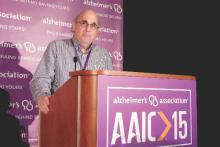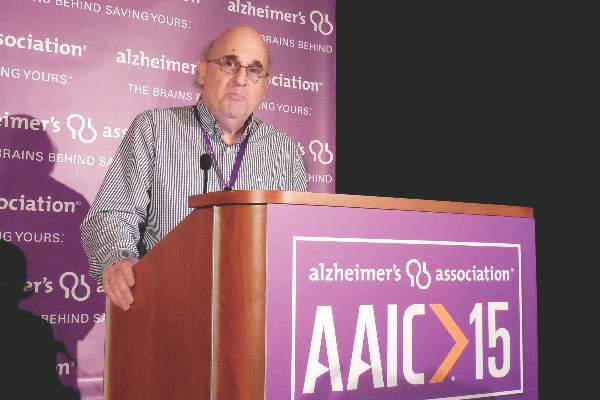User login
WASHINGTON – Proving disease modification of Alzheimer’s disease in a clinical drug trial may not be easy.
Some researchers developing drugs for treating Alzheimer’s disease hope to find a way to tweak the classic, double-blind, phase III trial design to gather data that can prove a drug has disease-modifying effects in addition to the standard goal of showing symptomatic treatment effects. But the complex statistical analyses they have developed to accomplish this faced some skepticism from Food and Drug Administration staff members during a panel discussion at a special session on the topic at the Alzheimer’s Association International Conference 2015.
“Everyone agrees that No. 1, we need to have drugs that are proven effective, but both clinicians and families want to know whether it’s important to start treatment of Alzheimer’s disease as early as possible or wait, and they want to know whether the benefits of treatment will persist or increase with time,” explained Dr. Paul Aisen, professor of neurology and director of the Alzheimer’s Therapeutic Research Institute at the University of Southern California, Los Angeles. Both properties – added value to patients from early initiation of treatment and persistent or accruing benefit from prolonged treatment – are hallmarks of a disease-modifying effect. “This is what we are trying to get at” with novel trial designs and analysis, he said in an interview. “It’s secondary to talking about efficacy, but it’s still clinically important.”
“Disease modification is an important concept because it indicates that the drug is affecting the underlying biology of the disease. What we have now [for treating Alzheimer’s disease] are drugs that only affect symptoms or are palliative,” commented Dr. David S. Knopman, professor of neurology at the Mayo Clinic in Rochester, Minn. and a participant in the session on disease modification at the meeting. “In principal a drug with a disease-modifying effect would have a bigger and more enduring effect and could be started earlier in the disease and would ultimately be of greater benefit to patients and society by reducing disease burden. The problem is that showing disease modification turns out to be very challenging,” Dr. Knopman said in an interview.
Solanezumab tested in delayed-start studies
During the session at the meeting, Dr. Aisen, the session organizer, presented results from post-hoc analysis of data collected in two phase III trials that tested the efficacy of the antiamyloid antibody solanezumab in patients with mild or moderate Alzheimer’s disease. Results from the placebo-controlled, double-blind phases of the two trials, EXPEDITION 1 and EXPEDITION 2, failed to show a statistically significant benefit from solanezumab treatment for the studies’ primary endpoint. Those findings appeared in a paper published last year (N Engl J Med. 2014 Jan 23;370:311-21).
The new analyses that Dr. Aisen reported came from the open-label extension phase of the two trials, which enabled patients originally enrolled in the placebo arms to start treatment on solanezumab, while patients from the active-treatment arms could remain on longer-term treatment with the drug. The new analyses also focused exclusively on patients who entered the study with “mild” Alzheimer’s disease, defined as a score on the Mini Mental State Examination of 20-26.
Post-hoc analysis of the combined trial results indicated that at the end of the 18-month, placebo-controlled phase patients who entered with mild Alzheimer’s disease had a statistically significant benefit from solanezumab treatment, compared with the placebo group. This observation led to the launch of a new trial, EXPEDITION 3, that exclusively enrolled patients with mild Alzheimer’s disease but in other ways resembled the first two failed trials. Results from EXPEDITION 3 are expected sometime in early 2017, Dr. Aisen said.
The analysis of extended treatment, which produced a trial design known as “delayed start,” aimed to test whether solanezumab produced disease modification of Alzheimer’s disease. The concept was that if the initial 18 months of drug treatment of patients in the active arm produced true disease modification then the difference in efficacy between the active and placebo arms in patients with mild disease seen at 18 months should remain roughly constant over subsequent months of solanezumab treatment of all patients, with no catchup by the patients first randomized to placebo and no hence no convergence of the outcome curves of the two treatment subgroups: patients on continuous solanezumab treatment and patients who first received placebo and then had a delayed start on solanezumab.
At the end of the EXPEDITION 1 and EXPEDITION 2 trials, 654 patients from the active-treatment arms remained enrolled and continued solanezumab treatment and 660 patients from the placebo arms remained enrolled and started solanezumab treatment for the first time. All patients continued on active treatment for up to 24 additional months, although many eventually dropped out of treatment and follow-up. After 2 years of extended treatment, 323 patients remained in the group that had initially been in the active treatment arms and 303 patients remained from those initially enrolled in the placebo arms.
Dr. Aisen presented results that compared the early-start and delayed-start subgroups by four different measures of efficacy, and each of the four analyses showed that the separation between the outcomes of the two treatment subgroups remained fairly constant during follow-up of as long as 2 years, findings consistent with the hypothesis of disease modification according to the statistical tests developed by researchers at Lilly, the company that sponsored the EXPEDITION studies and is developing solanezumab. “The curves are consistent across measures and over time. The late-start group did not appear to catch up. The shape of the curves supports disease modification,” Dr. Aisen said.
“This is the first time that a delayed start methodology has been analyzed in an Alzheimer’s disease clinical trial,” he noted.
The FDA’s view
Several staffers from the FDA who formed a panel at the session to discuss the results and the delayed-start trial design as a way to try to prove disease modification expressed skepticism about the validity and relevance of this analysis.
“The delayed-start design is a clever idea, but it is tough to establish disease modification,” said Lisa LaVange, Ph.D., director of biostatistics in the FDA’s Center for Drug Evaluation and Research. “The new methods [for analyzing delayed-start outcomes] are intriguing, but you want to show that the difference doesn’t deteriorate with time, and that requires the first difference [at the end of the placebo-controlled phase] to be significant and meaningful. You need to show first one thing, and then another, and that’s complicated.”
Dr. LaVange also highlighted the issue of many patients dropping out from the extended-treatment phase. “One of the biggest problems with delayed start is the missing-data problem. We need to be very careful when imputing missing data for dropouts. The missing data aspect of delayed start needs more attention.”
Another concern voiced by the FDA staffers who commented on delayed-start trials and trying to prove disease modification was the paramount importance of showing efficacy during the placebo-controlled phase of the trial.
“We want to modify the disease, but the prize is clearly a large treatment effect. Disease modification is absolutely not required for drug approval,” said Dr. William Dunn, director of the division of neurology products for the FDA’s Center for Drug Evaluation and Research. “What we are after is a treatment effect.”
The EXPEDITION trials and the delayed-start analysis for disease modification effects were funded by Lilly, the company developing solanezumab. Dr. Aisen has received research support from Lilly. Dr. Knopman received an honorarium from Lilly for chairing the data and safety-monitoring committee for two of their trials through 2012, but since then he has not had a financial relationship with the company. He currently is an investigator in a trial sponsored by Lilly. Dr. Knopman said he has no other disclosures. Dr. LaVange and Dr. Dunn had no disclosures.
On Twitter @mitchelzoler
WASHINGTON – Proving disease modification of Alzheimer’s disease in a clinical drug trial may not be easy.
Some researchers developing drugs for treating Alzheimer’s disease hope to find a way to tweak the classic, double-blind, phase III trial design to gather data that can prove a drug has disease-modifying effects in addition to the standard goal of showing symptomatic treatment effects. But the complex statistical analyses they have developed to accomplish this faced some skepticism from Food and Drug Administration staff members during a panel discussion at a special session on the topic at the Alzheimer’s Association International Conference 2015.
“Everyone agrees that No. 1, we need to have drugs that are proven effective, but both clinicians and families want to know whether it’s important to start treatment of Alzheimer’s disease as early as possible or wait, and they want to know whether the benefits of treatment will persist or increase with time,” explained Dr. Paul Aisen, professor of neurology and director of the Alzheimer’s Therapeutic Research Institute at the University of Southern California, Los Angeles. Both properties – added value to patients from early initiation of treatment and persistent or accruing benefit from prolonged treatment – are hallmarks of a disease-modifying effect. “This is what we are trying to get at” with novel trial designs and analysis, he said in an interview. “It’s secondary to talking about efficacy, but it’s still clinically important.”
“Disease modification is an important concept because it indicates that the drug is affecting the underlying biology of the disease. What we have now [for treating Alzheimer’s disease] are drugs that only affect symptoms or are palliative,” commented Dr. David S. Knopman, professor of neurology at the Mayo Clinic in Rochester, Minn. and a participant in the session on disease modification at the meeting. “In principal a drug with a disease-modifying effect would have a bigger and more enduring effect and could be started earlier in the disease and would ultimately be of greater benefit to patients and society by reducing disease burden. The problem is that showing disease modification turns out to be very challenging,” Dr. Knopman said in an interview.
Solanezumab tested in delayed-start studies
During the session at the meeting, Dr. Aisen, the session organizer, presented results from post-hoc analysis of data collected in two phase III trials that tested the efficacy of the antiamyloid antibody solanezumab in patients with mild or moderate Alzheimer’s disease. Results from the placebo-controlled, double-blind phases of the two trials, EXPEDITION 1 and EXPEDITION 2, failed to show a statistically significant benefit from solanezumab treatment for the studies’ primary endpoint. Those findings appeared in a paper published last year (N Engl J Med. 2014 Jan 23;370:311-21).
The new analyses that Dr. Aisen reported came from the open-label extension phase of the two trials, which enabled patients originally enrolled in the placebo arms to start treatment on solanezumab, while patients from the active-treatment arms could remain on longer-term treatment with the drug. The new analyses also focused exclusively on patients who entered the study with “mild” Alzheimer’s disease, defined as a score on the Mini Mental State Examination of 20-26.
Post-hoc analysis of the combined trial results indicated that at the end of the 18-month, placebo-controlled phase patients who entered with mild Alzheimer’s disease had a statistically significant benefit from solanezumab treatment, compared with the placebo group. This observation led to the launch of a new trial, EXPEDITION 3, that exclusively enrolled patients with mild Alzheimer’s disease but in other ways resembled the first two failed trials. Results from EXPEDITION 3 are expected sometime in early 2017, Dr. Aisen said.
The analysis of extended treatment, which produced a trial design known as “delayed start,” aimed to test whether solanezumab produced disease modification of Alzheimer’s disease. The concept was that if the initial 18 months of drug treatment of patients in the active arm produced true disease modification then the difference in efficacy between the active and placebo arms in patients with mild disease seen at 18 months should remain roughly constant over subsequent months of solanezumab treatment of all patients, with no catchup by the patients first randomized to placebo and no hence no convergence of the outcome curves of the two treatment subgroups: patients on continuous solanezumab treatment and patients who first received placebo and then had a delayed start on solanezumab.
At the end of the EXPEDITION 1 and EXPEDITION 2 trials, 654 patients from the active-treatment arms remained enrolled and continued solanezumab treatment and 660 patients from the placebo arms remained enrolled and started solanezumab treatment for the first time. All patients continued on active treatment for up to 24 additional months, although many eventually dropped out of treatment and follow-up. After 2 years of extended treatment, 323 patients remained in the group that had initially been in the active treatment arms and 303 patients remained from those initially enrolled in the placebo arms.
Dr. Aisen presented results that compared the early-start and delayed-start subgroups by four different measures of efficacy, and each of the four analyses showed that the separation between the outcomes of the two treatment subgroups remained fairly constant during follow-up of as long as 2 years, findings consistent with the hypothesis of disease modification according to the statistical tests developed by researchers at Lilly, the company that sponsored the EXPEDITION studies and is developing solanezumab. “The curves are consistent across measures and over time. The late-start group did not appear to catch up. The shape of the curves supports disease modification,” Dr. Aisen said.
“This is the first time that a delayed start methodology has been analyzed in an Alzheimer’s disease clinical trial,” he noted.
The FDA’s view
Several staffers from the FDA who formed a panel at the session to discuss the results and the delayed-start trial design as a way to try to prove disease modification expressed skepticism about the validity and relevance of this analysis.
“The delayed-start design is a clever idea, but it is tough to establish disease modification,” said Lisa LaVange, Ph.D., director of biostatistics in the FDA’s Center for Drug Evaluation and Research. “The new methods [for analyzing delayed-start outcomes] are intriguing, but you want to show that the difference doesn’t deteriorate with time, and that requires the first difference [at the end of the placebo-controlled phase] to be significant and meaningful. You need to show first one thing, and then another, and that’s complicated.”
Dr. LaVange also highlighted the issue of many patients dropping out from the extended-treatment phase. “One of the biggest problems with delayed start is the missing-data problem. We need to be very careful when imputing missing data for dropouts. The missing data aspect of delayed start needs more attention.”
Another concern voiced by the FDA staffers who commented on delayed-start trials and trying to prove disease modification was the paramount importance of showing efficacy during the placebo-controlled phase of the trial.
“We want to modify the disease, but the prize is clearly a large treatment effect. Disease modification is absolutely not required for drug approval,” said Dr. William Dunn, director of the division of neurology products for the FDA’s Center for Drug Evaluation and Research. “What we are after is a treatment effect.”
The EXPEDITION trials and the delayed-start analysis for disease modification effects were funded by Lilly, the company developing solanezumab. Dr. Aisen has received research support from Lilly. Dr. Knopman received an honorarium from Lilly for chairing the data and safety-monitoring committee for two of their trials through 2012, but since then he has not had a financial relationship with the company. He currently is an investigator in a trial sponsored by Lilly. Dr. Knopman said he has no other disclosures. Dr. LaVange and Dr. Dunn had no disclosures.
On Twitter @mitchelzoler
WASHINGTON – Proving disease modification of Alzheimer’s disease in a clinical drug trial may not be easy.
Some researchers developing drugs for treating Alzheimer’s disease hope to find a way to tweak the classic, double-blind, phase III trial design to gather data that can prove a drug has disease-modifying effects in addition to the standard goal of showing symptomatic treatment effects. But the complex statistical analyses they have developed to accomplish this faced some skepticism from Food and Drug Administration staff members during a panel discussion at a special session on the topic at the Alzheimer’s Association International Conference 2015.
“Everyone agrees that No. 1, we need to have drugs that are proven effective, but both clinicians and families want to know whether it’s important to start treatment of Alzheimer’s disease as early as possible or wait, and they want to know whether the benefits of treatment will persist or increase with time,” explained Dr. Paul Aisen, professor of neurology and director of the Alzheimer’s Therapeutic Research Institute at the University of Southern California, Los Angeles. Both properties – added value to patients from early initiation of treatment and persistent or accruing benefit from prolonged treatment – are hallmarks of a disease-modifying effect. “This is what we are trying to get at” with novel trial designs and analysis, he said in an interview. “It’s secondary to talking about efficacy, but it’s still clinically important.”
“Disease modification is an important concept because it indicates that the drug is affecting the underlying biology of the disease. What we have now [for treating Alzheimer’s disease] are drugs that only affect symptoms or are palliative,” commented Dr. David S. Knopman, professor of neurology at the Mayo Clinic in Rochester, Minn. and a participant in the session on disease modification at the meeting. “In principal a drug with a disease-modifying effect would have a bigger and more enduring effect and could be started earlier in the disease and would ultimately be of greater benefit to patients and society by reducing disease burden. The problem is that showing disease modification turns out to be very challenging,” Dr. Knopman said in an interview.
Solanezumab tested in delayed-start studies
During the session at the meeting, Dr. Aisen, the session organizer, presented results from post-hoc analysis of data collected in two phase III trials that tested the efficacy of the antiamyloid antibody solanezumab in patients with mild or moderate Alzheimer’s disease. Results from the placebo-controlled, double-blind phases of the two trials, EXPEDITION 1 and EXPEDITION 2, failed to show a statistically significant benefit from solanezumab treatment for the studies’ primary endpoint. Those findings appeared in a paper published last year (N Engl J Med. 2014 Jan 23;370:311-21).
The new analyses that Dr. Aisen reported came from the open-label extension phase of the two trials, which enabled patients originally enrolled in the placebo arms to start treatment on solanezumab, while patients from the active-treatment arms could remain on longer-term treatment with the drug. The new analyses also focused exclusively on patients who entered the study with “mild” Alzheimer’s disease, defined as a score on the Mini Mental State Examination of 20-26.
Post-hoc analysis of the combined trial results indicated that at the end of the 18-month, placebo-controlled phase patients who entered with mild Alzheimer’s disease had a statistically significant benefit from solanezumab treatment, compared with the placebo group. This observation led to the launch of a new trial, EXPEDITION 3, that exclusively enrolled patients with mild Alzheimer’s disease but in other ways resembled the first two failed trials. Results from EXPEDITION 3 are expected sometime in early 2017, Dr. Aisen said.
The analysis of extended treatment, which produced a trial design known as “delayed start,” aimed to test whether solanezumab produced disease modification of Alzheimer’s disease. The concept was that if the initial 18 months of drug treatment of patients in the active arm produced true disease modification then the difference in efficacy between the active and placebo arms in patients with mild disease seen at 18 months should remain roughly constant over subsequent months of solanezumab treatment of all patients, with no catchup by the patients first randomized to placebo and no hence no convergence of the outcome curves of the two treatment subgroups: patients on continuous solanezumab treatment and patients who first received placebo and then had a delayed start on solanezumab.
At the end of the EXPEDITION 1 and EXPEDITION 2 trials, 654 patients from the active-treatment arms remained enrolled and continued solanezumab treatment and 660 patients from the placebo arms remained enrolled and started solanezumab treatment for the first time. All patients continued on active treatment for up to 24 additional months, although many eventually dropped out of treatment and follow-up. After 2 years of extended treatment, 323 patients remained in the group that had initially been in the active treatment arms and 303 patients remained from those initially enrolled in the placebo arms.
Dr. Aisen presented results that compared the early-start and delayed-start subgroups by four different measures of efficacy, and each of the four analyses showed that the separation between the outcomes of the two treatment subgroups remained fairly constant during follow-up of as long as 2 years, findings consistent with the hypothesis of disease modification according to the statistical tests developed by researchers at Lilly, the company that sponsored the EXPEDITION studies and is developing solanezumab. “The curves are consistent across measures and over time. The late-start group did not appear to catch up. The shape of the curves supports disease modification,” Dr. Aisen said.
“This is the first time that a delayed start methodology has been analyzed in an Alzheimer’s disease clinical trial,” he noted.
The FDA’s view
Several staffers from the FDA who formed a panel at the session to discuss the results and the delayed-start trial design as a way to try to prove disease modification expressed skepticism about the validity and relevance of this analysis.
“The delayed-start design is a clever idea, but it is tough to establish disease modification,” said Lisa LaVange, Ph.D., director of biostatistics in the FDA’s Center for Drug Evaluation and Research. “The new methods [for analyzing delayed-start outcomes] are intriguing, but you want to show that the difference doesn’t deteriorate with time, and that requires the first difference [at the end of the placebo-controlled phase] to be significant and meaningful. You need to show first one thing, and then another, and that’s complicated.”
Dr. LaVange also highlighted the issue of many patients dropping out from the extended-treatment phase. “One of the biggest problems with delayed start is the missing-data problem. We need to be very careful when imputing missing data for dropouts. The missing data aspect of delayed start needs more attention.”
Another concern voiced by the FDA staffers who commented on delayed-start trials and trying to prove disease modification was the paramount importance of showing efficacy during the placebo-controlled phase of the trial.
“We want to modify the disease, but the prize is clearly a large treatment effect. Disease modification is absolutely not required for drug approval,” said Dr. William Dunn, director of the division of neurology products for the FDA’s Center for Drug Evaluation and Research. “What we are after is a treatment effect.”
The EXPEDITION trials and the delayed-start analysis for disease modification effects were funded by Lilly, the company developing solanezumab. Dr. Aisen has received research support from Lilly. Dr. Knopman received an honorarium from Lilly for chairing the data and safety-monitoring committee for two of their trials through 2012, but since then he has not had a financial relationship with the company. He currently is an investigator in a trial sponsored by Lilly. Dr. Knopman said he has no other disclosures. Dr. LaVange and Dr. Dunn had no disclosures.
On Twitter @mitchelzoler
AT AAIC 2015




